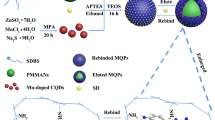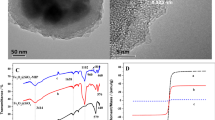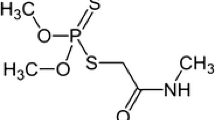Abstract
A novel dual-function material was synthesized by anchoring a molecularly imprinted polymer (MIP) layer on Mn-doped ZnS quantum dots (QDs) via a sol–gel process using 3-aminopropyltriethoxysilane (APTES) as a functional monomer, tetraethoxysilane (TEOS) as cross-linker, and nicosulfuron as template through a surface imprinting method. The amino groups in the APTES interact with the functional groups in the template molecules to form a complex through hydrogen bonding. The energy of the QDs was transferred to the complex, resulting in the quenching of the QDs and thus decreasing the fluorescence intensity, which allowed the nicosulfuron to be sensed optically. Fluorescence intensity from MIP-coated QDs was more strongly quenched by nicosulfuron than that of the non-imprinted polymer, which indicated that the MIP-coated QDs which acted as a fluorescence probe could selectively recognize nicosulfuron. Under the optimal conditions, it can detect down to 1.1 nmol L−1 of nicosulfuron, and a linear relationship has been obtained covering the concentration range of 12–6000 nmol L−1. The recoveries were in the range from 89.6 to 96.5 %, and the relative standard deviations were in the range of 2.5–5.7 %. The present study established a new strategy to combine inorganic (Mn-doped ZnS QDs)-organic MIPs, which is successfully applied to determine nicosulfuron in water samples.




Similar content being viewed by others
References
Turco A, Corvaglia S, Mazzotta E (2015) Electrochemical sensor for sulfadimethoxine based on molecularly imprinted polypyrrole: study of imprinting parameters. Bisoens Bioelectron 63:240–247
Hrichi H, Louhaichi MR, Monser L, Adhoum N (2014) Gliclazide voltammetric sensor based on electropolymerizedmolecularly imprinted polypyrrole film onto glassy carbon electrode. Sensor Actuat B 204:42–49
Chen LX, Xu SF, Li JH (2011) Recent advances in molecular imprinting technology: current status, challenges and highlighted applications. Chem Soc Rev 40:2922–2942
Song RY, Hu XL, Guan P, Li J, Zhao N, Wang QL (2014) Molecularly imprinted solid-phase extraction of glutathione from urine samples. Mat Sci Eng C 44:69–75
Zarejousheghani M, Fiedler P, Moser M, Borsdorf H (2014) Selective mixed-bed solid phase extraction of atrazine herbicide from environmental water samples using molecularly imprinted polymer. Talanta 129:132–138
Peeters M, Kobben S, Jiménez-Monroy KL, Modesto L, Kraus M, Vandenryt T, Gaulke A, Grinsven B, Ingebrandt S, Junkers T, Wagner P (2014) Thermal detection of histamine with a graphene oxide based molecularly imprinted polymer platform prepared by reversible addition–fragmentation chain transfer polymerization. Sensor Actuat B 203:527–535
Huang DL, Wang RZ, Liu YG, Zeng GM, Lai C, Xu P, Lu BA, Xu JJ, Wang C, Huang C (2015) Application of molecularly imprinted polymers in wastewater treatment: a review. Environ Sci Pollut Res 22:963–977
Lépinay S, Kham K, Millot MC, Carbonnier B (2012) In-situ polymerized molecularly imprinted polymeric thin films used as sensing layers in surface plasmon resonance sensors: mini-review focused on 2010–2011. Chem Pap 66:340–351
Pavlović DM, Nikšić K, Livazović S, Brnardić I, Anžlovar A (2015) Preparation and application of sulfaguanidine-imprinted polymer on solid-phase extraction of pharmaceuticals from water. Talanta 131:99–107
Zhou WB, Baneyx F (2014) Biofabrication of ZnS:Mn luminescent nanocrystals using histidine, hexahistidine, and His-tagged proteins: a comparison study. Biochem Eng J 89:28–32
Akshya S, Hariharan PS, Kumar VV, Anthony SP (2015) Surface functionalized fluorescent CdS QDs: selective fluorescence switching and quenching by Cu2+ and Hg2+ at wide pH range. Spectrochim Acta A 135:335–341
Yu LB, Li Z, Liu YB, Cheng F (2014) Synthesis of hierarchical TiO2 flower-rod and application in CdSe/CdS co-sensitized solar cell. J Power Sources 270:42–52
Wu N, Wyart Y, Siozade L, Georges G, Moulin P (2014) Characterization of ultrafiltration membranes fouled by quantum dots by confocal lasers canning microscopy. J Membrane Sci 470:40–51
Chen J, Pan JY, Du QG, Alagappan G, Lei W, Li Q, Xia J (2014) Highly efficient white quantum dot light-emitting diode based on ZnO quantum dot. Appl Phys A 117:589–591
Edmundson MC, Capeness M, Horsfall L (2014) Exploring the potential of metallic nanoparticles within synthetic biology. New Biotechnol 31:572–578
Bücking W, Massadeh S, Merkulov A, Xu S, Nann T (2010) Electrophoretic properties of BSA-coated quantum dots. Anal Bioanal Chem 396:1087–1094
Xu SF, Lu HZ, Li JH, Song XL, Wang AX, Chen LX, Han SB (2013) Dummy molecularly imprinted polymers-capped CdTe quantum dots for the fluorescent sensing of 2,4,6-Trinitrotoluene. Applied Materials and Interfaces 5:8146–8154
Zhang Z, Li JH, Wang XY, Shen DZ, Chen LX (2015) Quantum dots based mesoporous structured imprinting microspheres for the sensitive fluorescent detection of phycocyanin. Applied Materials and Interfaces 7:9118–9127
Rajabi HR, Farsi M (2015) Quantum dot based photocatalytic decolorization as an efficient and green strategy for the removal of anionic dye. Mat Sci Semicon Proc 31:478–486
Rajabi HR, Khani O, Shamsipur M, Vatanpour V (2013) High-performance pure and Fe3+-ion doped ZnS quantum dots as green nanophotocatalysts for the removal of malachite green under UV-light irradiation. J Hazard Mater 250–251:370–378
Shamsipur M, Rajabi HR (2014) Pure zinc sulfide quantum dot as highly selective luminescent probe for determination of hazardous cyanide ion. Mat Sci Eng C 36:139–145
Fenoll J, Hellín P, Sabater P, Flores P, Navarro S (2012) Trace analysis of sulfonylurea herbicides in water samples by solid-phase extraction and liquid chromatography-tandem mass spectrometry. Talanta 101:273–282
Zhou QX, Wang WD, Xiao JP (2006) Preconcentration and determination of nicosulfuron, thifensulfuron-methyl and metsulfuron-methyl in water samples using carbon nanotubes packed cartridge in combination with high performance liquid chromatography. Anal Chim Acta 559:200–206
Springer VH, Aprile F, Lista AG (2014) Determination of sulfonylureas in cereal samples with electrophoretic method using ionic liquid with dispersed carbon nanotubes as electrophoretic buffer. Food Chem 143:348–353
Ferrer I, Thurman EM (2007) Multi-residue method for the analysis of 101 pesticides and their degradates in food and water samples by liquid chromatography/time-of-flight mass spectrometry. J Chromatogr A 1175:24–37
Sharma D, Nagpal A, Pakade YB, Katnoria JK (2010) Analytical methods for estimation of organophosphorus pesticide residues in fruits and vegetables: a review. Talanta 82:1077–1089
Liu JX, Chen H, Lin Z, Lin JM (2010) Preparation of surface imprinting polymer capped Mn-Doped ZnS quantum dots and their application for chemiluminescence detection of 4-nitrophenol in tap water. Anal Chem 82:7380–7386
Tu RY, Liu BH, Wang ZY, Gao DM, Wang F, Fang QL, Zhang ZP (2008) Amine-capped ZnS-Mn2+ nanocrystals for fluorescence detection of trace TNT explosive. Anal Chem 80:3458–3465
Wang HF, He Y, Ji TR, Yan XP (2009) Surface molecular imprinting on Mn-Doped ZnS quantum dots for room-temperature phosphorescence optosensing of pentachlorophenol in water. Anal Chem 81:1615–1621
Zhao YY, Ma YX, Li H, Wang LY (2012) Composite QDs@MIP nanospheres for specific recognition and direct fluorescent quantification of pesticides in aqueous media. Anal Chem 84:386–395
Yang LQ, Zhao XM, Zhou J (2010) Selective enrichment and determination of nicosulfuron in water and soil by a stir bar based on molecularly imprinted polymer coatings. Anal Chim Acta 670:72–77
Ye GB, Zhang W, Xin C, Pan CP, Jiang SR (2006) Determination and quantitation of ten sulfonylurea herbicides in soil samples using liquid chromatography with electrospray ionization mass spectrometric detection. Chinese J Anal Chem 34:1207–1212
Si BJ, Zhou J (2011) Non-hydrolytic sol–gel methodology to prepare a molecularly imprinted, organic-silica hybrid-based stir bar for recognition of sulfonylurea herbicides. Chinese J Chem 29:2487–2494
Gallitzendorfer R, Timm T, Koch D, Küsters M, Gerhartz M (2011) Simultaneous determination of 12 sulfonylurea herbicides in drinking water after SPE by LC-DAD. Chromatographia 73:813–816
Shi JY, Li XY, Liu C, Shao MY, Zhang HJ, Zhang HQ, Yu AM, Chen YH (2014) Determination of sulfonylurea herbicides in pears using hollow fiber-protected magnetized solvent-bar liquid-phase microextraction HPLC. Chromatographia 77:1283–1290
Acknowledgments
This work was supported by the National Natural Science Foundation of China (No. 21205010), Fundamental Research Funds for the Central Universities (No. 2572014EB06), and Heilong Jiang Postdoctoral Funds for scientific research initiation (No. LBH-Q14001).
Conflict of interest
The authors declare that they have no conflict of interests.
Author information
Authors and Affiliations
Corresponding author
Electronic supplementary material
Below is the link to the electronic supplementary material.
ESM 1
(PDF 29 kb)
Rights and permissions
About this article
Cite this article
Ren, X., Chen, L. Preparation of molecularly imprinted polymer coated quantum dots to detect nicosulfuron in water samples. Anal Bioanal Chem 407, 8087–8095 (2015). https://doi.org/10.1007/s00216-015-8982-x
Received:
Revised:
Accepted:
Published:
Issue Date:
DOI: https://doi.org/10.1007/s00216-015-8982-x




